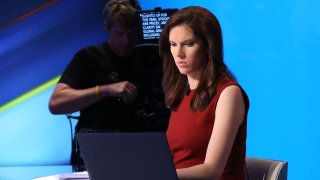
The main--dare I say, the only--weapon in the macro bears' arsenal right now is the flattening yield curve. When the Fed hiked rates yesterday, the five-year Treasury yield rose to a higher level than the 10-year, so that portion of the curve inverted. The spread between two-year and 10-year yields also flattened, to as low as 0.19 points this morning, down from 0.85 points at the start of the year.
Cue panic that the Fed is making a historic mistake by tightening policy--not just with yesterday's hike, but in their projections showing they expect to tighten six more times this year, once per meeting. The two-year/ten-year yield spread in particular has been a favorite leading indicator of recessions. It has pretty much always inverted before downturns, and rarely inverted otherwise (chart here). And obviously, we're close to it inverting right now.
"The Fed has never tightened into such a maelstrom before--a shooting war, a pandemic, a weak and wobbly stock market, and an incredibly flat yield curve," warned economist David Rosenberg in a client note this morning.
It sounds bad. Unless...you look at a slightly different version of the yield curve that actually just steepened to a five-year high! The same 10-year yield compared to three-month Treasury bills instead has the same predictive power (chart here), and widened to 1.75 points yesterday, the highest level since March 2017.
Get DFW local news, weather forecasts and entertainment stories to your inbox. Sign up for NBC DFW newsletters.
Count MKM chief economist and market strategist Michael Darda among those who are not taking any cues from curves based off of the two-year yield right now. "It's giving you a rate that incorporates [market expectations] over a two-year period that have not occurred," he wrote yesterday. "If one insists on using this measure, we would recommend also watching the risk neutral curve*, which is nowhere near inverting."
It's why he prefers comparing the 10-year with the Fed's actual policy rate (the "Fed funds" rate they just hiked yesterday to a range of 0.25% to 0.5%), or a close proxy for it--like three-month Treasury bills, which are trading around 0.4% today. Again, that curve has steepened this year--a bullish sign--and is at its widest levels in five years.
And that is the case even with the 10-year yield also potentially less reliable than normal right now, "pinned down by excessively low terminal rate expectations [and] distortions from global QE," as Darda has written. (More about this here). If longer-term yields "normalize" as QE ends and the Fed makes clear it plans to raise rates a lot more than the market anticipates, the 10-year yield could be significantly higher, which would steepen all of the curves.
Money Report
To that end, the Fed published a crucial update in its projections yesterday that showed members now expect the short-term Fed funds rate to hit 2.8% by the end of next year--up from only 1.6% in their December projections. In just three months' time, in other words, as inflation has shot way higher than anyone at the Fed expected, the committee is signaling the need for almost ten rate hikes by late next year, roughly twice as many as they previously thought necessary.
And yet the market either doesn't believe them, or thinks we'll be in recession as a result. That's the only way you can explain the 10-year Treasury yielding just 2.15% this morning. Most people's knee-jerk assumption is that the market must be right and recession is coming. The flip-side view is that the market is using the wrong framework, and rates will move higher as it becomes clear that the expansion isn't over--and inflation isn't evaporating.
Chair Powell tried to make this point in his press conference yesterday, noting that although the Fed trimmed its GDP forecast, the expansion is still very much intact. "Aggregate demand is currently strong...the labor market is also very strong...all signs are that this is a strong economy--indeed, one that will be able to flourish...in the face of less-accommodative monetary policy," he said.
From that point of view, in fact, the Fed still isn't being aggressive enough. Their own growth and inflation projections now show real rates will remain negative--meaning, massively stimulative--all the way through the end of 2023. Their same projections also now imply that their nominal (combined real and inflation) GDP forecast was just raised for this year; "if that is the case than the entire expected rate hiking path this year is still TOO LOW," Darda wrote.
And if all of that is true, it would make sense that the yield curve--the 10-year versus three-month--is steepening in anticipation of a continuing nominal demand boom, one that could keep exerting upward pressure on inflation. Don't be so sure that the Fed is tightening too much right now; they may not be tightening enough.
See you at 1 p.m!
Kelly
*Risk-neutral means you take out the "term premium," which is usually positive but is currently negative because of strong market demand for Treasury instruments, meaning longer-term yields would otherwise be higher right now.






